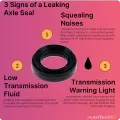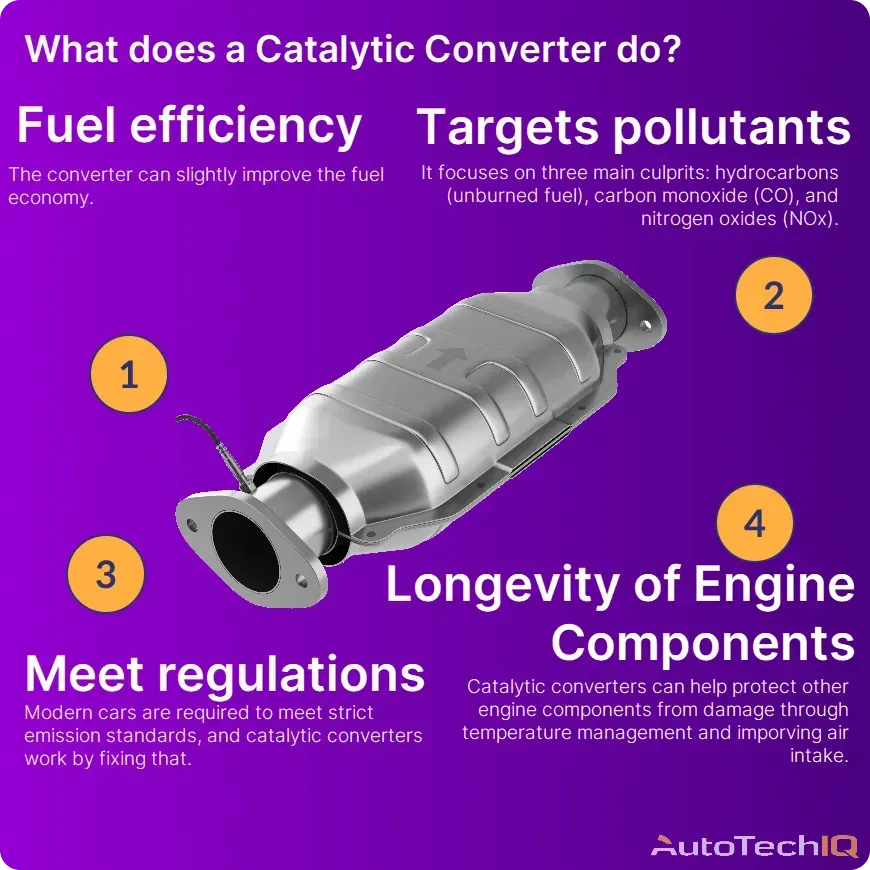
The catalytic converter is like a filter for the air that your engine releases when the vehicle is driving. Since the engine releases bad gases and toxic fumes because of the combustion that happens, it needs a filter to make these gases less toxic. This filter is the catalytic converter. So, the gas transformation goes like this: your engine -> bad gases -> travels to the catalytic converter -> turns into not-so-bad gases -> goes to the environment.
Reducing harmful emissions
Targets pollutants: It focuses on three main culprits: hydrocarbons (unburned fuel), carbon monoxide (CO), and nitrogen oxides (NOx). These gases contribute to smog, acid rain, and other environmental issues.
Conversion process: Inside the converter, a honeycomb-like ceramic structure coated with precious metals like platinum, palladium, and rhodium triggers chemical reactions. These reactions transform the harmful pollutants into:
-
- Water vapor (H2O): This is harmless and simply exits the exhaust pipe.
- Carbon dioxide (CO2): While a greenhouse gas, it's much less harmful than CO and NOx.
- Nitrogen (N2): This is the main component of air and poses no threat.
Additional benefits:
- Improved fuel efficiency: By ensuring complete combustion of fuel, the converter can slightly improve the fuel economy and EVAP system performance.
- Compliance with regulations: Modern cars are required to meet strict emission standards, and catalytic converters play a vital role in achieving compliance.
Here are some interesting facts about catalytic converters:
- They can convert up to 90% of harmful emissions into less harmful ones.
- They are sensitive to damage from improper engine maintenance, such as using leaded gasoline or exceeding oil change intervals.
- They are quite valuable due to the precious metals they contain, making them a target for theft in some areas.
What happens when a catalytic converter goes bad?
When something inside a catalytic converter goes bad, it loses its ability to effectively convert harmful emissions. This can lead to a range of problems for your car and the environment. Here are some of the key consequences:
Increased emissions
- Harmful pollutants: The main problem is that unburned hydrocarbons, carbon monoxide, and nitrogen oxides are released into the air untreated. These contribute to smog, acid rain, and other environmental issues.
- Failing emissions tests: In many areas, regular emissions testing is required. A faulty converter will likely cause your car to fail these tests, potentially leading to fines or driving restrictions.
Performance issues
- Reduced power and acceleration: The engine may not run as efficiently due to incomplete combustion, leading to decreased power and sluggish acceleration. It might even enter "reduced engine power" mode.

- Fuel inefficiency: As the engine struggles to burn fuel properly, your car's fuel economy will likely suffer.
- Check engine light: The car's computer will often detect the malfunction and trigger the check engine light.
Other symptoms
- Rotten egg smell: A rotten egg smell is a telltale sign of a failing converter, caused by the release of sulfur-containing compounds.
- Louder exhaust: Damage to the converter's internal structure can cause rattling or other unusual noises from the exhaust system.
- Engine overheating: In severe cases, a clogged converter can restrict exhaust flow, leading to overheating.
- Engine sputtering: A clogged catalytic converter can cause the engine to sputter and have the "check engine" warning become active.

It's important to address a failing catalytic converter promptly. Ignoring the issue can worsen the problems mentioned above and potentially damage other engine components. Replacing the converter can be expensive, but it's necessary to restore proper emissions control and vehicle performance.
Here are some additional points to consider:
- Causes of catalytic converter failure: Common causes include internal damage from overheating, contamination from engine fluids like oil or coolant, and wear and tear over time. A clogged catalytic converter can quickly develop.
- Maintenance tips: Regular oil changes and using the correct fuel type can help prolong the life of your catalytic converter.
- Professional diagnosis: If you suspect a problem, have your car diagnosed by a qualified mechanic to confirm the issue and recommend the appropriate repair.
By understanding the consequences of a bad catalytic converter, you can take steps to ensure your car runs clean and efficiently.
Can I drive with a bad catalytic converter?
While technically, you can drive with a slightly failing catalytic converter for short distances, it's generally not recommended and comes with several risks and drawbacks. Here's a breakdown:
Short-term driving
Minimal impact: If the converter is only partially clogged, you might not notice significant immediate issues beyond a slight decrease in performance or fuel economy.
Long-term driving and risks
Environmental damage: You'll be releasing more harmful gases and pollutants into the air, contributing to environmental concerns like smog and acid rain.
Further damage: Driving with a failing converter can worsen the problem, leading to complete clogging and potentially damaging other engine components. This can result in more expensive repairs later.
Legal issues: In some areas, failing emissions tests due to a bad converter can lead to fines or driving restrictions.
Safety concerns: In rare cases, a heavily clogged converter can restrict hot exhaust gases' flow enough to overheat the engine, posing a safety risk.
Alternatives to consider
Repair or replace the converter: This is the best option for long-term environmental and vehicle health. While costly, it addresses the root cause and prevents further damage.
Seek professional advice: If you're unsure about the severity of the issue or your options, consult a qualified mechanic for a diagnosis and recommendations.
Ultimately, the decision to drive with a bad catalytic converter rests with you. However, it's essential to weigh the potential risks and costs before doing so.
Why do people scrap catalytic converters?
People scrap catalytic converters for two main reasons: money and ease of theft.
High value due to precious metals
Catalytic converters contain valuable metals like platinum, palladium, and rhodium. These metals are used as catalysts in the conversion process and are essential for reducing harmful emissions.
The prices of these metals fluctuate but can reach significant heights. For example, in 2023, rhodium was the most expensive precious metal in the world by weight.
Even small amounts of these metals can fetch a good price when extracted and recycled.
Easy to steal
Catalytic converters are often located underneath vehicles, making them accessible to thieves. They're easy to find under the car. That's why they often burn leaking oil, as they catch the drops before they reach the ground.

In many cases, they can be removed with simple tools and relatively quickly, requiring minimal technical expertise.
This combination of high value and easy access makes them a target for theft, particularly in areas with lax regulations or enforcement against scrap metal dealers.
However, it's important to emphasize that:
- Scrapping stolen catalytic converters is illegal. It contributes to crime and environmental damage.
- Legitimate recycling programs exist for end-of-life converters, allowing responsible owners to recover some value while benefiting the environment.
- Buying scrapped converters without proper documentation is unethical and supports the illegal market.
If you're considering selling a catalytic converter, ensure it comes from a legitimate source and that the recycling program operates responsibly.
Can your car run without a catalytic converter?
Technically, a car can still run without a catalytic converter. The internal combustion engine in itself relies on the spark plugs igniting fuel in the cylinders, not the presence of the catalytic converter. However, while the engine might technically function, doing so is illegal and comes with several negative consequences:
Legality
- Most countries and regions have laws requiring vehicles to meet specific emission standards. Driving without a catalytic converter almost certainly violates these regulations, leading to fines or even impounding your vehicle.
- Emission testing: Many areas require regular emissions tests. With a missing converter, your car will almost certainly fail the test, further restricting your ability to drive legally.
While it's true that removing a catalytic converter might be technically possible and might not immediately damage your engine, the legal and environmental implications make it a bad idea. It's considered a crime in many states.
How long do catalytic converters last?
The lifespan of a catalytic converter can vary depending on several factors, but typically they can last anywhere from 10 years or 100,000 miles to the lifetime of the vehicle. Here's a breakdown of what influences their longevity:
Factors affecting lifespan
Driving habits: Gentle driving with regular maintenance extends lifespan. Harsh driving, towing heavy loads, or frequent short trips can shorten it.
Vehicle type: Larger engines tend to put more stress on the converter, potentially decreasing its lifespan.
Fuel quality: Using the correct fuel type recommended by your car's manufacturer is crucial. Leaded gasoline or low-quality fuel can damage the converter.
Maintenance: Regular oil changes and engine tune-ups ensure optimal engine performance, benefiting the converter's lifespan.
Environmental conditions: Exposure to extreme temperatures, dust, or debris can increase wear and tear on the converter.
Signs of a failing catalytic converter
Illuminated check engine light: This often indicates an issue with the emission system, including the converter. So, when a catalytic converter goes bad, the check engine light typically activates.

Reduced engine performance: You might experience decreased power, acceleration, or fuel efficiency.
Strong rotten egg smell: This is a telltale sign of sulfur compounds released due to a malfunctioning converter.
Louder exhaust noise: A damaged converter can cause rattling or other unusual noises from the exhaust system.
Recommendations
Consult your car's owner's manual: It usually specifies recommended maintenance intervals for the catalytic converter, including inspections and potential replacements.
Have your car regularly inspected by a qualified mechanic: They can identify potential issues with the converter early on.
Address any engine problems promptly: Unresolved issues like oil leaks or misfires can damage the converter.
Use the correct fuel type: Refer to your owner's manual for the recommended fuel octane rating.
Consider aftermarket catalytic converters: When replacement is necessary, explore options that meet your budget and environmental preferences.
Can a catalytic converter be cleaned?
While there are various methods and products claiming to clean catalytic converters, the effectiveness of cleaning a clogged converter is highly debated and generally considered unreliable. Here's a breakdown of the different perspectives:
Arguments against cleaning:
- Limited reach: Most cleaning methods struggle to reach the deeper layers of the converter where clogs often occur.
- Ineffective against certain contaminants: Cleaning methods might not address the specific type of contaminant causing the clog.
- Potential damage: Improper cleaning methods or harsh chemicals can damage the converter's delicate internal structure, worsening the problem.
- Ignoring the root cause: Cleaning might be a temporary solution if the underlying issue causing the clog (e.g., oil burning on the engine) isn't addressed.
Arguments for cleaning:
- Potential cost savings: Cleaning can be cheaper than replacing the converter, especially if the clog is minor.
- Possible success in specific cases: In rare cases, mild clogs caused by specific contaminants might respond to cleaning.
Overall, it's crucial to approach catalytic converter cleaning with caution. Here's what I recommend:
- Consult a qualified mechanic: They can diagnose the cause of the clog and advise you on the best course of action. They can also assess the feasibility of cleaning in your specific case.
- Be wary of quick fixes and miracle cures: Remember, most claims of easy cleaning solutions are likely exaggerated.
- Consider the potential risks: Weigh the potential benefits of cleaning against the risks of damage or ineffective results.
- Prioritize fixing the underlying cause: If the clog is caused by an engine issue, address it first before attempting cleaning.
Ultimately, the decision to clean your catalytic converter depends on your specific situation, budget, and risk tolerance. Consulting a professional mechanic for a proper diagnosis and guidance is always the safest and most reliable approach.
Do you need O2 sensors without the catalytic converter?
The answer to whether you need an O2 sensor without a catalytic converter depends on several factors:
Type of O2 sensor:
-
Front (upstream) O2 sensor: This sensor plays a crucial role in the air/fuel ratio control system, regardless of the presence of a catalytic converter. Even without a converter, the engine needs the front O2 sensor to send feedback to the computer for optimal air/fuel mixture and engine performance.
-
Rear (downstream) O2 sensor: This sensor primarily monitors the efficiency of the catalytic converter. If you don't have a converter, you don't need the rear O2 sensor. In fact, its presence might confuse the engine computer and cause issues.
Reason for missing catalytic converter:
-
Illegal removal: Removing a catalytic converter is illegal in most countries due to its role in emission control. In such cases, having any O2 sensor is irrelevant and poses an environmental risk.
-
Replacement in progress: During repairs or replacement, having the O2 sensors temporarily disconnected is normal. Once the new converter is installed, both sensors become necessary again.
Does removing the catalytic converter affect gas mileage?
The effect of removing a catalytic converter on gas mileage is complex and depends on several factors:
Potential for slight improvement:
-
Reduced backpressure: Removing the converter eliminates some restrictions on exhaust flow, which theoretically might allow the engine to operate slightly more efficiently, potentially leading to a small increase in gas mileage.
However, this potential improvement is often negated or outweighed by other factors:
-
Fuel mapping issues: Modern vehicles' fuel injection systems are calibrated to operate with a catalytic converter in place. Removing it can upset this delicate balance, causing the engine to run richer (using more fuel) to compensate for the perceived lack of oxygen in the exhaust.
-
Sensor malfunctions: The absence of a converter can trigger trouble codes and illuminate the check engine light, indicating issues to the engine computer. This can lead to the computer entering "limp mode" or adjusting various parameters, often resulting in worse fuel economy.
-
Environmental damage: The increased emissions caused by removing the converter outweigh any potential gains in fuel efficiency from a purely environmental standpoint.
Therefore, removing a catalytic converter for the sole purpose of improving gas mileage is generally not recommended. The potential benefits are minimal and often negated by drawbacks, while the associated environmental damage and legal repercussions make it a poor choice.
Additional considerations:
-
Performance issues: While some claim removing the converter improves power, this is often accompanied by reduced torque and decreased responsiveness at lower RPMs.
-
Safety concerns: In rare cases, a clogged exhaust system due to a missing converter can overheat the engine, posing a safety hazard.
How do I stop my catalytic converter from being stolen?
Here are some legal and responsible ways to deter theft and protect your catalytic converter:
Parking:
- Park in well-lit, populated areas, preferably indoors or within secured parking lots. Thieves are less likely to target vehicles in areas with good visibility and potential witnesses.
- Consider parking strategically, and positioning the side with the catalytic converter closer to walls or fences, making it harder for thieves to access.
Deterrence measures:
- Engrave your vehicle identification number (VIN) onto the catalytic converter. This can make it easier to identify and return if stolen and may deter buyers on the black market. Some programs like CarSafe offer free etching services.
- Install anti-theft devices designed for catalytic converters. These can be shields, cages, or alarms that make removal more difficult or time-consuming.
- Choose aftermarket catalytic converters with theft-resistant features, such as welded seams or anti-tamper designs.
Reporting:
- Report any suspicious activity or attempted thefts to the police immediately. Provide details like the time, location, and any vehicle descriptions you recall. This can help authorities track down criminals and deter future attempts.
Catalytic Converter FAQ
1. What exactly does a catalytic converter do?
It helps clean up your car’s exhaust. It takes harmful gases from the engine and turns them into less harmful stuff before they come out of the tailpipe.
2. Why is it important?
Because without it, your car would pollute the air a lot more. Plus, your car can fail an emissions test without one, and that means no registration.
3. Can I drive without one?
Technically, yes—but you shouldn’t. It’s illegal in many places, your car will pollute more, and it might even mess up your engine over time.
4. How do I know if my catalytic converter is bad?
Some signs include a rotten egg smell, poor fuel economy, engine misfires, or your check engine light turning on. Sometimes your car might also feel sluggish.
5. Why are people stealing catalytic converters?
They have metals like platinum and rhodium inside that are worth a lot of money. Thieves can steal them quickly and sell them for cash.
6. How can I protect mine from being stolen?
You can buy a shield or cage that makes it harder to cut out. Parking in well-lit or secure areas also helps.
7. How much does it cost to replace one?
It can be anywhere from $500 to over $2,000, depending on your car. The part itself is pricey because of those special metals inside.
8. Can I clean it instead of replacing it?
Sometimes, yes. If it’s just dirty or clogged, some mechanics can clean it out or recommend a fuel additive. But if it’s damaged or totally blocked, you’ll need a new one.
9. Is it covered by warranty?
Often, yes. Catalytic converters are usually covered under the emissions warranty, which is longer than the basic one. Check your car’s manual or ask your dealership.
10. What causes it to go bad in the first place?
Bad spark plugs, burning oil, or engine problems can clog it or overheat it. So if your engine’s acting up, fix it early to avoid killing your converter.
Other news
-
Car is Squealing When Driving
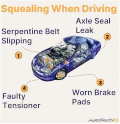
-
What is Preventative Maintenance and What Are The Benefits of it?

-
JobViewIQ - DVI Process Training - Part of the Auto Care Alliance Benefits

-
7 Signs of AC Pulley Issues
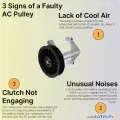
-
7 Signs of Clogged AC Components
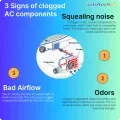
-
How Much Does a Transmission Fluid Change Cost?
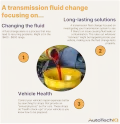
-
7 Signs of a Leaking Axle Seal
